My sweetie Ellen was reading survival basics on a prepper website (she has a strong Boy Scout approach to life) 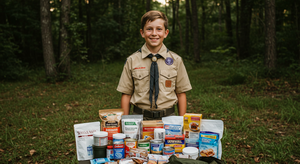 when she came across the most basic data possible for designing a survival diet. It said that the three most basic and critical elements for long-term survival were protein foods (meaning clean meat or seafood), omega-3 oil, and vitamin C. You can survive on nothing but protein, C, and omega-3 oil for a long time. This is essentially what many Eskimos do; in fact, they survive on it. Sugar is not needed. Vegetables are not needed. Grains and legumes are not needed. Fiber is not needed. You can forget the whole USDA food pyramid – just protein and omega-3 oils. It’s something to think about.
when she came across the most basic data possible for designing a survival diet. It said that the three most basic and critical elements for long-term survival were protein foods (meaning clean meat or seafood), omega-3 oil, and vitamin C. You can survive on nothing but protein, C, and omega-3 oil for a long time. This is essentially what many Eskimos do; in fact, they survive on it. Sugar is not needed. Vegetables are not needed. Grains and legumes are not needed. Fiber is not needed. You can forget the whole USDA food pyramid – just protein and omega-3 oils. It’s something to think about.
Well, how much protein do we need? The actual number is based on what our ideal weight would be, not our actual wei ght. So if you are very tall and muscular, you will need more protein than a tiny person with a slim build. Also, age plays into the picture because with age, we become less able to digest and metabolize protein, so we need to eat more of it to compensate. The ideal weight for most people is somewhere between 120 lbs and 180 lbs. That means their complete protein need is somewhere between 70 grams and 110 grams. About 6% of the population will fall outside this range, but this is good for most people. For context, that comes to somewhere between 11 and 18 eggs a day. I choose eggs for my context because egg white is the most perfect and complete protein. As you can readily see with this egg measurement example, many and likely most of you are not eating enough protein each day.
ght. So if you are very tall and muscular, you will need more protein than a tiny person with a slim build. Also, age plays into the picture because with age, we become less able to digest and metabolize protein, so we need to eat more of it to compensate. The ideal weight for most people is somewhere between 120 lbs and 180 lbs. That means their complete protein need is somewhere between 70 grams and 110 grams. About 6% of the population will fall outside this range, but this is good for most people. For context, that comes to somewhere between 11 and 18 eggs a day. I choose eggs for my context because egg white is the most perfect and complete protein. As you can readily see with this egg measurement example, many and likely most of you are not eating enough protein each day.
So why focus on protein when this article is titled low-fat? Because much of the fat we consume is paired with pr otein. And when we eat enough protein, we usually end up eating a lot of fat. Figuring out how to get our protein needs met without overdoing the fat is the challenge. Now in a survival situation, you want all the fat you can scrounge up. Fat equals calories you need to survive. Every gram of fat is 9 calories, while protein is only 4 calories. And from those numbers I coughed up with earlier, the calories you get from obtaining all the protein you need is only between 280 to 440 calories.
otein. And when we eat enough protein, we usually end up eating a lot of fat. Figuring out how to get our protein needs met without overdoing the fat is the challenge. Now in a survival situation, you want all the fat you can scrounge up. Fat equals calories you need to survive. Every gram of fat is 9 calories, while protein is only 4 calories. And from those numbers I coughed up with earlier, the calories you get from obtaining all the protein you need is only between 280 to 440 calories.
This is not a lot of calories. Our omega-3 need is only a bout a gram a day, which only contributes a whopping 9 calories to the protein-need calories. A lean person could not survive for long on so few calories, but a fat person has 3500 calories in storage for every pound of excess fat they are carrying around. Getting their calorie needs met means they could survive for 2 days for each pound of excess weight they have. Put another way, if you wanted to lose 50 pounds, you could eat just your basic protein need, and it would take you 100 days. (That is a gross estimate. Other hormonal things come into play.)
bout a gram a day, which only contributes a whopping 9 calories to the protein-need calories. A lean person could not survive for long on so few calories, but a fat person has 3500 calories in storage for every pound of excess fat they are carrying around. Getting their calorie needs met means they could survive for 2 days for each pound of excess weight they have. Put another way, if you wanted to lose 50 pounds, you could eat just your basic protein need, and it would take you 100 days. (That is a gross estimate. Other hormonal things come into play.)
So how does all of this come into play for an article on l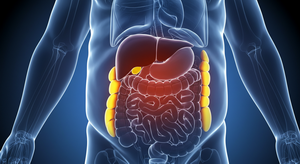 ow fat? There are several reasons for wanting to do a therapeutic low-fat diet. Probably the most important is the issue of visceral fat, that fat that deposits around the organs in the abdomen. This is the fat that corresponds to insulin resistance and eventually diabetes, as well as inflammation in the arteries leading to atherosclerosis and heart disease. The fat we carry in the thighs, hips, arms, and the belly fat that is outside the abdominal muscles does produce inflammation, but it does not create the kind of metabolic damage that the visceral fat does. This is the fat we really want to get rid of for our health, and a low-fat diet is one way to do that. If you want to know how much visceral fat you have, here is a calculator to calculate that with: https://www.lih.lu/en/visceral-fat-calculator/
ow fat? There are several reasons for wanting to do a therapeutic low-fat diet. Probably the most important is the issue of visceral fat, that fat that deposits around the organs in the abdomen. This is the fat that corresponds to insulin resistance and eventually diabetes, as well as inflammation in the arteries leading to atherosclerosis and heart disease. The fat we carry in the thighs, hips, arms, and the belly fat that is outside the abdominal muscles does produce inflammation, but it does not create the kind of metabolic damage that the visceral fat does. This is the fat we really want to get rid of for our health, and a low-fat diet is one way to do that. If you want to know how much visceral fat you have, here is a calculator to calculate that with: https://www.lih.lu/en/visceral-fat-calculator/
Low fat is not enough by itself. If you eat a ton of sugars and carbs, you will not lose any visceral fat. In fact, it is the carbs that are most strongly related to forming the visceral fat in the first place. Folks on high-fat ketogenic diets are less prone to forming visceral fat. It seems that insulin resistance is a big factor in forming visceral fat. However, too many calories in general can override this. So the real key to getting rid of visceral fat is cutting both the carbs and the fat. That is why I focused on protein in the beginning. But even protein has nuanced issues because big loads of protein also trigger an insulin response and eventual insulin resistance. This introduces the concept of protein pacing. To keep protein from triggering insulin, we want to eat our protein in 4 to 5 small meals per day. An average would be 15 to 25 grams of protein every 3 hours during the day for 5 small meals a day. Start these meals early in the day because there is some research that shows greater mortality for folks that start eating later in the day by skipping breakfast.
and carbs, you will not lose any visceral fat. In fact, it is the carbs that are most strongly related to forming the visceral fat in the first place. Folks on high-fat ketogenic diets are less prone to forming visceral fat. It seems that insulin resistance is a big factor in forming visceral fat. However, too many calories in general can override this. So the real key to getting rid of visceral fat is cutting both the carbs and the fat. That is why I focused on protein in the beginning. But even protein has nuanced issues because big loads of protein also trigger an insulin response and eventual insulin resistance. This introduces the concept of protein pacing. To keep protein from triggering insulin, we want to eat our protein in 4 to 5 small meals per day. An average would be 15 to 25 grams of protein every 3 hours during the day for 5 small meals a day. Start these meals early in the day because there is some research that shows greater mortality for folks that start eating later in the day by skipping breakfast.
Protein pacing also has the benefit of practically erasing  hunger. Protein is the most satiating food, and eating it every three hours keeps our body feeling like it has had enough food to eat. Pacing is great for two reasons, but we still need to lower our total calorie intake. Ultimately, it is depriving our body of all the calories it wants that causes it to start burning up the visceral fat to make up the difference. It will still mostly burn up other fat in the body, but gradually, the visceral fat will come off if we are successful at avoiding blood sugar swings that produce a bunch of insulin being released. If we just do low fat but still eat sugar and simple carbs, even if technically we are still at a calorie deficit each day, we will not lose any visceral fat. So, no sugary treats. You might still be able to lose fat, but it won’t be the nasty visceral fat we really need to get rid of.
hunger. Protein is the most satiating food, and eating it every three hours keeps our body feeling like it has had enough food to eat. Pacing is great for two reasons, but we still need to lower our total calorie intake. Ultimately, it is depriving our body of all the calories it wants that causes it to start burning up the visceral fat to make up the difference. It will still mostly burn up other fat in the body, but gradually, the visceral fat will come off if we are successful at avoiding blood sugar swings that produce a bunch of insulin being released. If we just do low fat but still eat sugar and simple carbs, even if technically we are still at a calorie deficit each day, we will not lose any visceral fat. So, no sugary treats. You might still be able to lose fat, but it won’t be the nasty visceral fat we really need to get rid of.
Now there are a few of you that are thinking this article does not apply to you because you have a perfect weight right now. Do the calculator to see if this is true. I have seen many MRIs and DEXA scans of thin people that still had way too much visceral fat. This fat hides deep in the core of your body where you can’t see it or feel it. One particularly bad form of this fat is the fat that infiltrates the liver to form a fatty liver. From there it is a short trip to cirrhosis of the liver and liver failure. Back in the old days this was primarily a concern for alcoholics, but these days we see the same liver fat accumulation being caused by the fructose in soda pop. High Fructose Corn Syrup causes major metabolic dysfunction. We don’t see this happening much from the fructose in fresh whole fruit because of the compensating action of the antioxidants in the fresh fruit and the action of the fibers in the gut. Fruit juice is somewhat of a problem, particularly if it has been heat treated (pasteurized). A heads up, agave syrup is up to 80% fructose, so it is super bad for you. Real honey does not seem to be a problem in limited quantities.
does not apply to you because you have a perfect weight right now. Do the calculator to see if this is true. I have seen many MRIs and DEXA scans of thin people that still had way too much visceral fat. This fat hides deep in the core of your body where you can’t see it or feel it. One particularly bad form of this fat is the fat that infiltrates the liver to form a fatty liver. From there it is a short trip to cirrhosis of the liver and liver failure. Back in the old days this was primarily a concern for alcoholics, but these days we see the same liver fat accumulation being caused by the fructose in soda pop. High Fructose Corn Syrup causes major metabolic dysfunction. We don’t see this happening much from the fructose in fresh whole fruit because of the compensating action of the antioxidants in the fresh fruit and the action of the fibers in the gut. Fruit juice is somewhat of a problem, particularly if it has been heat treated (pasteurized). A heads up, agave syrup is up to 80% fructose, so it is super bad for you. Real honey does not seem to be a problem in limited quantities.
So let’s round this story up. The villain today is visceral fat and fatty liver. The negative outcome is heart disease an d diabetes along with the occasional failed liver. The remedy is to stimulate the body to burn up its visceral fat by forcing the body to supply calories missing from the diet. A second consideration is that we must be careful not to trigger the body to release insulin as this will block the release of visceral fat. We want to do this without feeling the hunger and we want to do this while still providing the body with all the nutrients it needs. What it needs most is protein, but we need to be careful not to eat so much protein at one sitting that it triggers an insulin release. This means eating the protein in small amounts,15 to 25 grams a meal, with about 3 hours of time between meals. We want to eat low fat in order to get the body to use its own fat. And we want to avoid sugars and simple carbs to avoid both the calories and the blood sugar response that raises insulin levels.
d diabetes along with the occasional failed liver. The remedy is to stimulate the body to burn up its visceral fat by forcing the body to supply calories missing from the diet. A second consideration is that we must be careful not to trigger the body to release insulin as this will block the release of visceral fat. We want to do this without feeling the hunger and we want to do this while still providing the body with all the nutrients it needs. What it needs most is protein, but we need to be careful not to eat so much protein at one sitting that it triggers an insulin release. This means eating the protein in small amounts,15 to 25 grams a meal, with about 3 hours of time between meals. We want to eat low fat in order to get the body to use its own fat. And we want to avoid sugars and simple carbs to avoid both the calories and the blood sugar response that raises insulin levels.
What does this look like? It looks like salads with vegetables and protein – either low fat meats or low fat and low car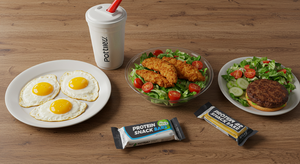 b vegetable sources of protein. It might look like soups with zero carb noodles and protein. It might look like hamburgers on a very low carb bread like Carbonaut bread. It might even be protein shakes as long as they are low calorie and contain no artificial sweeteners. (Artificial sweeteners can trigger diabetes.) Stevia, Monk fruit, and allulose are fine for sweetness. Treats look like fresh berries. It generally takes a while, but it is not a forever plan. It is just until we get rid of that nasty visceral fat.
b vegetable sources of protein. It might look like soups with zero carb noodles and protein. It might look like hamburgers on a very low carb bread like Carbonaut bread. It might even be protein shakes as long as they are low calorie and contain no artificial sweeteners. (Artificial sweeteners can trigger diabetes.) Stevia, Monk fruit, and allulose are fine for sweetness. Treats look like fresh berries. It generally takes a while, but it is not a forever plan. It is just until we get rid of that nasty visceral fat.
Take care,
David
Ellen
Ellen’s trainer Luka has two little girls that Ellen likes to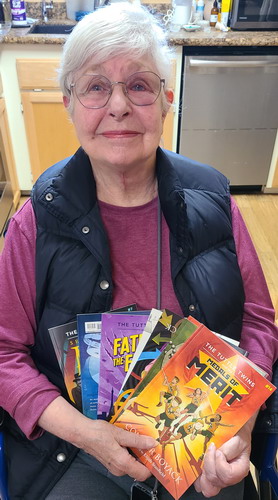 pretend are granddaughters. In a desire to support the girls Ellen bought a series of children’s books that are specifically designed to foster critical thinking skills. Even though the girls are only age 9 and 6, you can never start teaching kids good thinking skills too early.
pretend are granddaughters. In a desire to support the girls Ellen bought a series of children’s books that are specifically designed to foster critical thinking skills. Even though the girls are only age 9 and 6, you can never start teaching kids good thinking skills too early.
| Diet drinks increase diabetes 88% in pregnant women
Less than 1 diet drink a day increased the chances of developing diabetes while pregnant by 88%. More made the likelihood even greater. Stevia, Monk fruit, and allulose were okay. It was the aspartame, sucralose, and similar artificial sweeteners that were the problem. of developing diabetes while pregnant by 88%. More made the likelihood even greater. Stevia, Monk fruit, and allulose were okay. It was the aspartame, sucralose, and similar artificial sweeteners that were the problem.
More
___________________________
“Everything you experience is your own perception and creation. Victim, aggressor, mediator, etc are all just roles we choose to get what we want.“~David DeLapp
_____________________________________
Late breakfast linked to health decline
Studying older adults an interesting finding show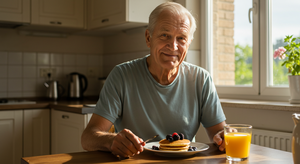 ed up regarding the timing of their meals. The later they ate their breakfasts the greater their mortality risk. This held true for night owls who also ate late as a result. Lunch and dinner timing did no seem to matter. ed up regarding the timing of their meals. The later they ate their breakfasts the greater their mortality risk. This held true for night owls who also ate late as a result. Lunch and dinner timing did no seem to matter.
More
____________________________
“You pay in some way for everything you ever get, there is no free ride. You can not take more than you give or the resource runs dry.“
~David DeLapp
________________________________________
Sleep builds muscle, bones, and metabolism
Researchers have finally discovered why sleep is so i mportant to health. While we sleep our brain sends pulses of growth hormone throughout the body to tell it to rebuild everything. mportant to health. While we sleep our brain sends pulses of growth hormone throughout the body to tell it to rebuild everything.
More
________________________
“Nothing risked, nothing gained. If you do not “show up” in life by risking and being vulnerable, you do not get to play… “
~David DeLapp
|
|
|














